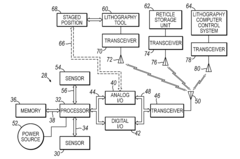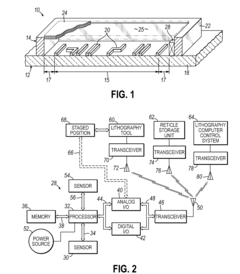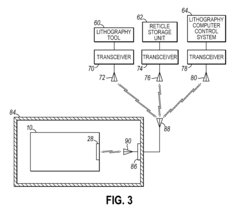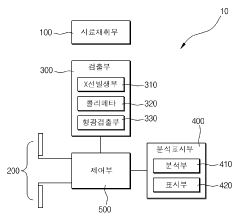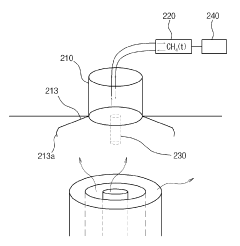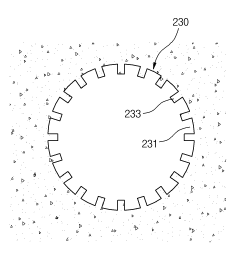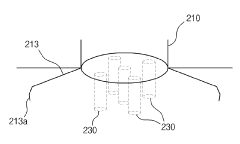Real-time photodiode monitoring for environmental analysis
AUG 21, 20259 MIN READ
Generate Your Research Report Instantly with AI Agent
Patsnap Eureka helps you evaluate technical feasibility & market potential.
Photodiode Tech Evolution
The evolution of photodiode technology for real-time environmental monitoring has been marked by significant advancements over the past few decades. Initially, photodiodes were primarily used in simple light detection applications, but their capabilities have expanded dramatically to enable sophisticated environmental analysis.
In the 1960s and 1970s, silicon-based photodiodes became commercially available, offering improved sensitivity and reliability compared to earlier selenium and germanium devices. These early silicon photodiodes laid the foundation for environmental sensing applications, though their use was limited by relatively low sensitivity and narrow spectral response.
The 1980s saw the introduction of PIN (Positive-Intrinsic-Negative) photodiodes, which offered enhanced sensitivity and faster response times. This development enabled more accurate real-time monitoring of light levels and basic environmental parameters. During this period, photodiodes began to be integrated into environmental monitoring systems, particularly for measuring air quality and detecting pollutants.
The 1990s brought about significant improvements in photodiode manufacturing techniques, resulting in devices with lower noise, higher quantum efficiency, and broader spectral response. These advancements allowed for more precise measurements of various environmental factors, including particulate matter and gas concentrations.
The turn of the millennium marked a new era for photodiode technology in environmental analysis. The development of avalanche photodiodes (APDs) provided unprecedented sensitivity, enabling the detection of extremely low light levels. This breakthrough allowed for more accurate measurements of trace pollutants and expanded the range of detectable environmental parameters.
In the 2010s, the integration of photodiodes with advanced signal processing and data analysis techniques revolutionized real-time environmental monitoring. Machine learning algorithms and artificial intelligence were employed to interpret complex photodiode signals, enabling more sophisticated and accurate environmental analysis.
Recent years have seen the emergence of multi-spectral and hyperspectral photodiode arrays, capable of simultaneously detecting multiple wavelengths of light. This technology has greatly enhanced the ability to identify and quantify various environmental pollutants and parameters in real-time, providing a more comprehensive picture of environmental conditions.
The miniaturization of photodiode technology has also played a crucial role in its evolution. The development of micro-electromechanical systems (MEMS) has led to the creation of highly compact and energy-efficient photodiode sensors, suitable for deployment in large-scale environmental monitoring networks and portable devices.
Looking ahead, the continued evolution of photodiode technology for environmental analysis is likely to focus on further improvements in sensitivity, spectral range, and integration with other sensing technologies. The development of novel materials and fabrication techniques promises to yield photodiodes with even greater performance and versatility, enabling more comprehensive and accurate real-time environmental monitoring.
In the 1960s and 1970s, silicon-based photodiodes became commercially available, offering improved sensitivity and reliability compared to earlier selenium and germanium devices. These early silicon photodiodes laid the foundation for environmental sensing applications, though their use was limited by relatively low sensitivity and narrow spectral response.
The 1980s saw the introduction of PIN (Positive-Intrinsic-Negative) photodiodes, which offered enhanced sensitivity and faster response times. This development enabled more accurate real-time monitoring of light levels and basic environmental parameters. During this period, photodiodes began to be integrated into environmental monitoring systems, particularly for measuring air quality and detecting pollutants.
The 1990s brought about significant improvements in photodiode manufacturing techniques, resulting in devices with lower noise, higher quantum efficiency, and broader spectral response. These advancements allowed for more precise measurements of various environmental factors, including particulate matter and gas concentrations.
The turn of the millennium marked a new era for photodiode technology in environmental analysis. The development of avalanche photodiodes (APDs) provided unprecedented sensitivity, enabling the detection of extremely low light levels. This breakthrough allowed for more accurate measurements of trace pollutants and expanded the range of detectable environmental parameters.
In the 2010s, the integration of photodiodes with advanced signal processing and data analysis techniques revolutionized real-time environmental monitoring. Machine learning algorithms and artificial intelligence were employed to interpret complex photodiode signals, enabling more sophisticated and accurate environmental analysis.
Recent years have seen the emergence of multi-spectral and hyperspectral photodiode arrays, capable of simultaneously detecting multiple wavelengths of light. This technology has greatly enhanced the ability to identify and quantify various environmental pollutants and parameters in real-time, providing a more comprehensive picture of environmental conditions.
The miniaturization of photodiode technology has also played a crucial role in its evolution. The development of micro-electromechanical systems (MEMS) has led to the creation of highly compact and energy-efficient photodiode sensors, suitable for deployment in large-scale environmental monitoring networks and portable devices.
Looking ahead, the continued evolution of photodiode technology for environmental analysis is likely to focus on further improvements in sensitivity, spectral range, and integration with other sensing technologies. The development of novel materials and fabrication techniques promises to yield photodiodes with even greater performance and versatility, enabling more comprehensive and accurate real-time environmental monitoring.
Environmental Analysis Market
The environmental analysis market has experienced significant growth in recent years, driven by increasing awareness of environmental issues and stricter regulations worldwide. This market encompasses a wide range of technologies and services aimed at monitoring and analyzing various environmental parameters, including air quality, water quality, soil contamination, and climate change indicators.
Real-time photodiode monitoring for environmental analysis represents a crucial segment within this market, offering rapid and continuous data collection capabilities. The demand for such technologies has been steadily rising due to their ability to provide instant feedback on environmental conditions, enabling quick decision-making and response to potential hazards.
The global environmental monitoring market size was valued at approximately $19.9 billion in 2020 and is projected to reach $28.9 billion by 2026, growing at a CAGR of 6.5% during the forecast period. Within this broader market, the segment for real-time monitoring solutions, including photodiode-based systems, is expected to witness even higher growth rates due to the increasing need for immediate data and actionable insights.
Key drivers of market growth include stringent environmental regulations, growing public awareness of environmental issues, and the need for continuous monitoring in industrial processes. Governments worldwide are implementing stricter environmental protection laws, necessitating advanced monitoring technologies. Industries such as manufacturing, oil and gas, and agriculture are increasingly adopting real-time monitoring solutions to ensure compliance and optimize their operations.
The Asia-Pacific region is anticipated to be the fastest-growing market for environmental analysis technologies, including real-time photodiode monitoring systems. This growth is attributed to rapid industrialization, urbanization, and increasing environmental concerns in countries like China and India. North America and Europe continue to be significant markets, driven by technological advancements and robust regulatory frameworks.
Challenges in the market include the high initial costs of advanced monitoring systems and the complexity of data interpretation. However, ongoing technological advancements, such as the integration of artificial intelligence and machine learning algorithms, are addressing these issues by improving data analysis capabilities and reducing overall system costs.
The COVID-19 pandemic has further highlighted the importance of environmental monitoring, particularly in indoor air quality assessment. This has led to increased interest in portable and real-time monitoring solutions, creating new opportunities for photodiode-based technologies in residential and commercial applications.
Real-time photodiode monitoring for environmental analysis represents a crucial segment within this market, offering rapid and continuous data collection capabilities. The demand for such technologies has been steadily rising due to their ability to provide instant feedback on environmental conditions, enabling quick decision-making and response to potential hazards.
The global environmental monitoring market size was valued at approximately $19.9 billion in 2020 and is projected to reach $28.9 billion by 2026, growing at a CAGR of 6.5% during the forecast period. Within this broader market, the segment for real-time monitoring solutions, including photodiode-based systems, is expected to witness even higher growth rates due to the increasing need for immediate data and actionable insights.
Key drivers of market growth include stringent environmental regulations, growing public awareness of environmental issues, and the need for continuous monitoring in industrial processes. Governments worldwide are implementing stricter environmental protection laws, necessitating advanced monitoring technologies. Industries such as manufacturing, oil and gas, and agriculture are increasingly adopting real-time monitoring solutions to ensure compliance and optimize their operations.
The Asia-Pacific region is anticipated to be the fastest-growing market for environmental analysis technologies, including real-time photodiode monitoring systems. This growth is attributed to rapid industrialization, urbanization, and increasing environmental concerns in countries like China and India. North America and Europe continue to be significant markets, driven by technological advancements and robust regulatory frameworks.
Challenges in the market include the high initial costs of advanced monitoring systems and the complexity of data interpretation. However, ongoing technological advancements, such as the integration of artificial intelligence and machine learning algorithms, are addressing these issues by improving data analysis capabilities and reducing overall system costs.
The COVID-19 pandemic has further highlighted the importance of environmental monitoring, particularly in indoor air quality assessment. This has led to increased interest in portable and real-time monitoring solutions, creating new opportunities for photodiode-based technologies in residential and commercial applications.
Real-time Monitoring Challenges
Real-time photodiode monitoring for environmental analysis faces several significant challenges that hinder its widespread adoption and effectiveness. One of the primary obstacles is the need for high sensitivity and accuracy in detecting minute changes in light intensity or spectral characteristics. Environmental factors such as temperature fluctuations, humidity, and atmospheric particles can interfere with measurements, leading to potential inaccuracies in data collection.
The development of robust and reliable sensors capable of withstanding harsh environmental conditions presents another hurdle. Photodiodes used in outdoor settings must be resistant to corrosion, temperature extremes, and physical damage while maintaining consistent performance over extended periods. This requirement often necessitates the use of specialized materials and protective enclosures, which can increase costs and complexity.
Data processing and interpretation pose additional challenges in real-time monitoring systems. The vast amount of data generated by continuous measurements requires sophisticated algorithms and computational power to filter out noise, identify relevant patterns, and extract meaningful insights. Ensuring low latency in data transmission and analysis is crucial for timely decision-making and response to environmental changes.
Power management is a critical concern, particularly for remote or off-grid monitoring stations. Balancing the need for continuous operation with energy efficiency often requires innovative solutions such as solar-powered systems or low-power consumption designs. This challenge is compounded by the need for reliable communication infrastructure to transmit data from remote locations to central processing facilities.
Calibration and maintenance of photodiode-based monitoring systems present ongoing challenges. Regular calibration is essential to ensure accuracy, but performing this task in the field can be difficult and time-consuming. Developing self-calibrating systems or remote calibration methods could significantly improve the reliability and efficiency of environmental monitoring networks.
Integrating real-time photodiode monitoring into existing environmental analysis frameworks and decision-making processes is another significant challenge. This integration requires not only technical compatibility but also the development of standardized protocols for data sharing and interpretation across different organizations and regulatory bodies.
Lastly, the cost-effectiveness of implementing and maintaining large-scale photodiode monitoring networks remains a barrier to widespread adoption. Balancing the need for high-quality, reliable measurements with budget constraints requires ongoing innovation in sensor design, data processing, and system integration to make real-time environmental monitoring more accessible and sustainable.
The development of robust and reliable sensors capable of withstanding harsh environmental conditions presents another hurdle. Photodiodes used in outdoor settings must be resistant to corrosion, temperature extremes, and physical damage while maintaining consistent performance over extended periods. This requirement often necessitates the use of specialized materials and protective enclosures, which can increase costs and complexity.
Data processing and interpretation pose additional challenges in real-time monitoring systems. The vast amount of data generated by continuous measurements requires sophisticated algorithms and computational power to filter out noise, identify relevant patterns, and extract meaningful insights. Ensuring low latency in data transmission and analysis is crucial for timely decision-making and response to environmental changes.
Power management is a critical concern, particularly for remote or off-grid monitoring stations. Balancing the need for continuous operation with energy efficiency often requires innovative solutions such as solar-powered systems or low-power consumption designs. This challenge is compounded by the need for reliable communication infrastructure to transmit data from remote locations to central processing facilities.
Calibration and maintenance of photodiode-based monitoring systems present ongoing challenges. Regular calibration is essential to ensure accuracy, but performing this task in the field can be difficult and time-consuming. Developing self-calibrating systems or remote calibration methods could significantly improve the reliability and efficiency of environmental monitoring networks.
Integrating real-time photodiode monitoring into existing environmental analysis frameworks and decision-making processes is another significant challenge. This integration requires not only technical compatibility but also the development of standardized protocols for data sharing and interpretation across different organizations and regulatory bodies.
Lastly, the cost-effectiveness of implementing and maintaining large-scale photodiode monitoring networks remains a barrier to widespread adoption. Balancing the need for high-quality, reliable measurements with budget constraints requires ongoing innovation in sensor design, data processing, and system integration to make real-time environmental monitoring more accessible and sustainable.
Current Photodiode Solutions
01 Real-time monitoring systems using photodiodes
Photodiodes are utilized in real-time monitoring systems for various applications. These systems can continuously measure and analyze light-based signals, providing instant feedback and data collection. The integration of photodiodes allows for precise and rapid detection of changes in light intensity or spectral characteristics, making them suitable for a wide range of monitoring tasks.- Real-time monitoring systems using photodiodes: Photodiodes are utilized in real-time monitoring systems for various applications. These systems can continuously measure and analyze light-based signals, providing instant feedback and data collection. The integration of photodiodes allows for precise and rapid detection of changes in light intensity or spectral characteristics, making them suitable for a wide range of monitoring tasks.
- Photodiode-based biosensors for medical diagnostics: Photodiodes are incorporated into biosensor devices for real-time medical diagnostics. These sensors can detect biological markers or changes in physiological parameters by measuring light interactions with biological samples. The use of photodiodes enables rapid and sensitive analysis, potentially allowing for point-of-care diagnostics and continuous health monitoring.
- Environmental monitoring using photodiode arrays: Arrays of photodiodes are employed in environmental monitoring systems to detect and measure various parameters such as air quality, water pollution, or radiation levels. These systems can provide real-time data on environmental conditions, allowing for quick response to changes or potential hazards. The use of multiple photodiodes enables comprehensive and simultaneous monitoring of different environmental factors.
- Photodiode-based quality control in manufacturing: Photodiodes are integrated into quality control systems in manufacturing processes for real-time monitoring of product characteristics or production parameters. These systems can detect defects, measure dimensions, or monitor material properties by analyzing light interactions. The use of photodiodes allows for continuous inspection and rapid identification of issues, improving overall product quality and production efficiency.
- Network performance monitoring using photodiode sensors: Photodiodes are used in optical network monitoring systems to assess and maintain network performance in real-time. These sensors can detect signal strength, wavelength accuracy, and other optical parameters critical for network operation. By continuously monitoring these factors, network operators can quickly identify and address issues, ensuring optimal performance and reliability of optical communication systems.
02 Photodiode-based sensing in medical devices
Photodiodes are incorporated into medical devices for real-time monitoring of physiological parameters. These sensors can detect changes in blood flow, oxygen saturation, or other bodily functions by measuring light absorption or reflection. The use of photodiodes in medical monitoring enables continuous patient assessment and early detection of potential health issues.Expand Specific Solutions03 Environmental monitoring with photodiode sensors
Photodiodes are employed in environmental monitoring systems to measure various parameters such as air quality, water pollution, or UV radiation levels. These sensors can provide real-time data on environmental conditions, allowing for quick response to changes or potential hazards. The use of photodiodes in this context enables continuous and accurate monitoring of environmental factors.Expand Specific Solutions04 Industrial process control using photodiode monitoring
Photodiodes are integrated into industrial process control systems for real-time monitoring of production lines, quality control, and safety measures. These sensors can detect changes in product characteristics, machine performance, or environmental conditions within manufacturing facilities. The use of photodiodes allows for immediate adjustments to processes, ensuring efficiency and product quality.Expand Specific Solutions05 Network and data transmission monitoring with photodiodes
Photodiodes are used in monitoring systems for optical networks and data transmission. These sensors can detect signal strength, data integrity, and potential issues in fiber optic communications. Real-time monitoring with photodiodes enables quick identification and resolution of network problems, ensuring reliable and efficient data transfer.Expand Specific Solutions
Key Environmental Sensor Manufacturers
The real-time photodiode monitoring for environmental analysis market is in a growth phase, driven by increasing environmental concerns and regulatory requirements. The market size is expanding, with a diverse range of players from research institutions to large corporations. Technologically, the field is advancing rapidly, with companies like UT-Battelle LLC, Tracsense AS, and ERG SpA leading innovation. The technology's maturity varies, with established players like Halliburton Energy Services and Siemens AG offering robust solutions, while newer entrants like Protect Environmental LLC focus on niche applications. Universities and research centers, such as the University of Tennessee Research Foundation and the Indian Institute of Science, contribute significantly to technological advancements, indicating a dynamic and evolving competitive landscape.
STMicroelectronics (Research & Development) Ltd.
Technical Solution: STMicroelectronics has developed a cutting-edge real-time photodiode monitoring system for environmental analysis. Their solution integrates high-performance silicon photomultipliers (SiPMs) with advanced analog front-end circuitry, enabling ultra-sensitive light detection[4]. The system incorporates on-chip temperature compensation and adaptive gain control, ensuring accurate measurements across varying environmental conditions[5]. STMicroelectronics has also implemented a novel time-gated detection scheme, which significantly improves the signal-to-noise ratio in challenging low-light conditions often encountered in environmental monitoring[6].
Strengths: Ultra-high sensitivity, robust performance in varying conditions. Weaknesses: Higher cost compared to traditional photodiodes, increased power consumption for advanced processing.
Horiba Ltd.
Technical Solution: Horiba Ltd. has developed advanced real-time photodiode monitoring systems for environmental analysis. Their technology utilizes high-sensitivity photodiodes coupled with sophisticated signal processing algorithms to detect and quantify various environmental pollutants. The system employs a multi-wavelength approach, allowing simultaneous measurement of multiple analytes[1]. Horiba's solution incorporates miniaturized optical components and integrated microfluidics, enabling portable and field-deployable devices for on-site environmental monitoring[2]. The company has also implemented machine learning algorithms to enhance data interpretation and reduce false positives in complex environmental matrices[3].
Strengths: High sensitivity, multi-analyte detection, portability. Weaknesses: Potential interference from complex environmental matrices, calibration requirements for diverse environments.
Innovative Photodiode Designs
Methods for real-time contamination, environmental, or physical monitoring of a photomask
PatentInactiveUS20100029021A1
Innovation
- A sensor package is physically attached to the photomask, capable of real-time monitoring and communication with a control system, detecting attributes such as contamination, temperature, humidity, and vibrations, and transmitting data wirelessly or through a wired connection to ensure timely quality control and prevent defects.
Remote real time analysing and monitoring device for multi phase and various kinds of environment pollutants
PatentActiveKR1020220121605A
Innovation
- A remote real-time analysis and monitoring device comprising a sample collection unit, sensor unit, detection unit, and control unit, equipped with a gas chamber and concentric underground closed holes, a guide plate, and an information transmission module, including GPS, to detect and analyze pollutants in real-time.
Data Processing Techniques
Data processing techniques play a crucial role in real-time photodiode monitoring for environmental analysis. These techniques are essential for extracting meaningful information from raw sensor data and transforming it into actionable insights. One of the primary methods employed is signal filtering, which helps remove noise and unwanted artifacts from the photodiode output. This process typically involves the application of digital filters, such as low-pass, high-pass, or band-pass filters, depending on the specific requirements of the environmental analysis.
Another important technique is signal amplification, which enhances the strength of weak signals detected by the photodiode. This is particularly useful when monitoring low-intensity light sources or when dealing with environmental conditions that may attenuate the signal. Amplification can be achieved through various means, including operational amplifiers or specialized integrated circuits designed for photodiode applications.
Data normalization is a critical step in ensuring consistent and comparable results across different monitoring sessions or devices. This process involves adjusting the raw data to a common scale, accounting for variations in sensor sensitivity, environmental conditions, and other factors that may influence the measurements. Normalization techniques may include min-max scaling, z-score normalization, or more advanced methods tailored to specific environmental analysis requirements.
Real-time data processing often involves the implementation of algorithms for peak detection and analysis. These algorithms are designed to identify and characterize significant changes in the photodiode output, which may correspond to specific environmental events or phenomena of interest. Common approaches include threshold-based detection, derivative analysis, and wavelet transforms, each offering different trade-offs between sensitivity, specificity, and computational complexity.
To handle the large volumes of data generated by continuous monitoring, efficient data compression techniques are often employed. These methods reduce the storage and transmission requirements while preserving the essential information content of the signals. Lossless compression algorithms, such as run-length encoding or Huffman coding, may be used when data integrity is paramount. In cases where some loss of precision is acceptable, lossy compression techniques like discrete cosine transform (DCT) or wavelet-based methods can achieve higher compression ratios.
Advanced data processing techniques for environmental analysis often incorporate machine learning and artificial intelligence approaches. These methods can be used for pattern recognition, anomaly detection, and predictive modeling based on historical photodiode data. Techniques such as neural networks, support vector machines, and decision trees can be trained to recognize complex patterns and make inferences about environmental conditions based on the processed photodiode signals.
Another important technique is signal amplification, which enhances the strength of weak signals detected by the photodiode. This is particularly useful when monitoring low-intensity light sources or when dealing with environmental conditions that may attenuate the signal. Amplification can be achieved through various means, including operational amplifiers or specialized integrated circuits designed for photodiode applications.
Data normalization is a critical step in ensuring consistent and comparable results across different monitoring sessions or devices. This process involves adjusting the raw data to a common scale, accounting for variations in sensor sensitivity, environmental conditions, and other factors that may influence the measurements. Normalization techniques may include min-max scaling, z-score normalization, or more advanced methods tailored to specific environmental analysis requirements.
Real-time data processing often involves the implementation of algorithms for peak detection and analysis. These algorithms are designed to identify and characterize significant changes in the photodiode output, which may correspond to specific environmental events or phenomena of interest. Common approaches include threshold-based detection, derivative analysis, and wavelet transforms, each offering different trade-offs between sensitivity, specificity, and computational complexity.
To handle the large volumes of data generated by continuous monitoring, efficient data compression techniques are often employed. These methods reduce the storage and transmission requirements while preserving the essential information content of the signals. Lossless compression algorithms, such as run-length encoding or Huffman coding, may be used when data integrity is paramount. In cases where some loss of precision is acceptable, lossy compression techniques like discrete cosine transform (DCT) or wavelet-based methods can achieve higher compression ratios.
Advanced data processing techniques for environmental analysis often incorporate machine learning and artificial intelligence approaches. These methods can be used for pattern recognition, anomaly detection, and predictive modeling based on historical photodiode data. Techniques such as neural networks, support vector machines, and decision trees can be trained to recognize complex patterns and make inferences about environmental conditions based on the processed photodiode signals.
Environmental Regulations
Environmental regulations play a crucial role in shaping the development and implementation of real-time photodiode monitoring systems for environmental analysis. These regulations establish the legal framework and standards that govern the use of such technologies in monitoring and assessing environmental conditions.
At the international level, organizations such as the United Nations Environment Programme (UNEP) and the World Health Organization (WHO) set guidelines for environmental monitoring and air quality standards. These guidelines often serve as a basis for national and regional regulations, influencing the design and deployment of photodiode-based monitoring systems.
In the United States, the Environmental Protection Agency (EPA) is responsible for setting and enforcing environmental regulations. The Clean Air Act and Clean Water Act, in particular, mandate the monitoring of various pollutants and contaminants. These regulations specify the required measurement frequencies, accuracy levels, and reporting protocols, which directly impact the design and operation of real-time photodiode monitoring systems.
The European Union has established comprehensive environmental regulations through directives such as the Air Quality Directive (2008/50/EC) and the Water Framework Directive (2000/60/EC). These directives set specific targets for air and water quality, necessitating advanced monitoring technologies like photodiode-based systems to ensure compliance.
Many countries have adopted their own environmental regulations, often building upon international standards. For instance, China's Environmental Protection Law and Japan's Air Pollution Control Act both include provisions for continuous monitoring of environmental parameters, creating a demand for real-time monitoring solutions.
Regulatory compliance often requires the use of certified monitoring equipment. Certification processes, such as those conducted by the EPA in the United States or TÜV in Europe, ensure that photodiode monitoring systems meet the necessary accuracy, reliability, and performance standards. This certification process can significantly influence the design and manufacturing of these systems.
Environmental regulations also dictate data management and reporting requirements. Real-time photodiode monitoring systems must be capable of collecting, storing, and transmitting data in formats compatible with regulatory reporting systems. This often necessitates the integration of advanced data processing and communication capabilities into the monitoring devices.
As environmental regulations continue to evolve, driven by growing concerns over climate change and public health, the requirements for environmental monitoring systems are likely to become more stringent. This regulatory landscape will continue to shape the development of real-time photodiode monitoring technologies, pushing for greater accuracy, reliability, and versatility in environmental analysis applications.
At the international level, organizations such as the United Nations Environment Programme (UNEP) and the World Health Organization (WHO) set guidelines for environmental monitoring and air quality standards. These guidelines often serve as a basis for national and regional regulations, influencing the design and deployment of photodiode-based monitoring systems.
In the United States, the Environmental Protection Agency (EPA) is responsible for setting and enforcing environmental regulations. The Clean Air Act and Clean Water Act, in particular, mandate the monitoring of various pollutants and contaminants. These regulations specify the required measurement frequencies, accuracy levels, and reporting protocols, which directly impact the design and operation of real-time photodiode monitoring systems.
The European Union has established comprehensive environmental regulations through directives such as the Air Quality Directive (2008/50/EC) and the Water Framework Directive (2000/60/EC). These directives set specific targets for air and water quality, necessitating advanced monitoring technologies like photodiode-based systems to ensure compliance.
Many countries have adopted their own environmental regulations, often building upon international standards. For instance, China's Environmental Protection Law and Japan's Air Pollution Control Act both include provisions for continuous monitoring of environmental parameters, creating a demand for real-time monitoring solutions.
Regulatory compliance often requires the use of certified monitoring equipment. Certification processes, such as those conducted by the EPA in the United States or TÜV in Europe, ensure that photodiode monitoring systems meet the necessary accuracy, reliability, and performance standards. This certification process can significantly influence the design and manufacturing of these systems.
Environmental regulations also dictate data management and reporting requirements. Real-time photodiode monitoring systems must be capable of collecting, storing, and transmitting data in formats compatible with regulatory reporting systems. This often necessitates the integration of advanced data processing and communication capabilities into the monitoring devices.
As environmental regulations continue to evolve, driven by growing concerns over climate change and public health, the requirements for environmental monitoring systems are likely to become more stringent. This regulatory landscape will continue to shape the development of real-time photodiode monitoring technologies, pushing for greater accuracy, reliability, and versatility in environmental analysis applications.
Unlock deeper insights with Patsnap Eureka Quick Research — get a full tech report to explore trends and direct your research. Try now!
Generate Your Research Report Instantly with AI Agent
Supercharge your innovation with Patsnap Eureka AI Agent Platform!
